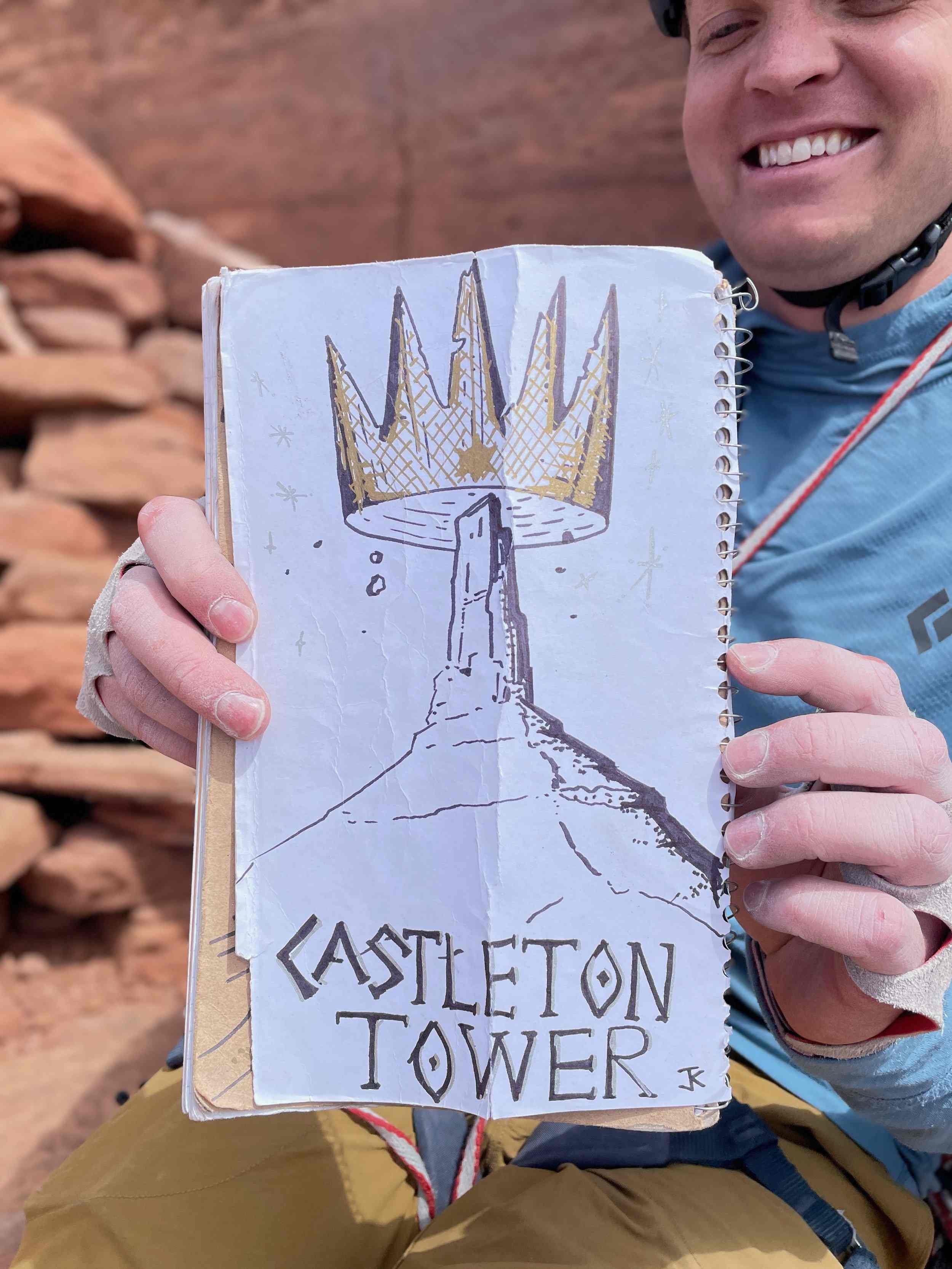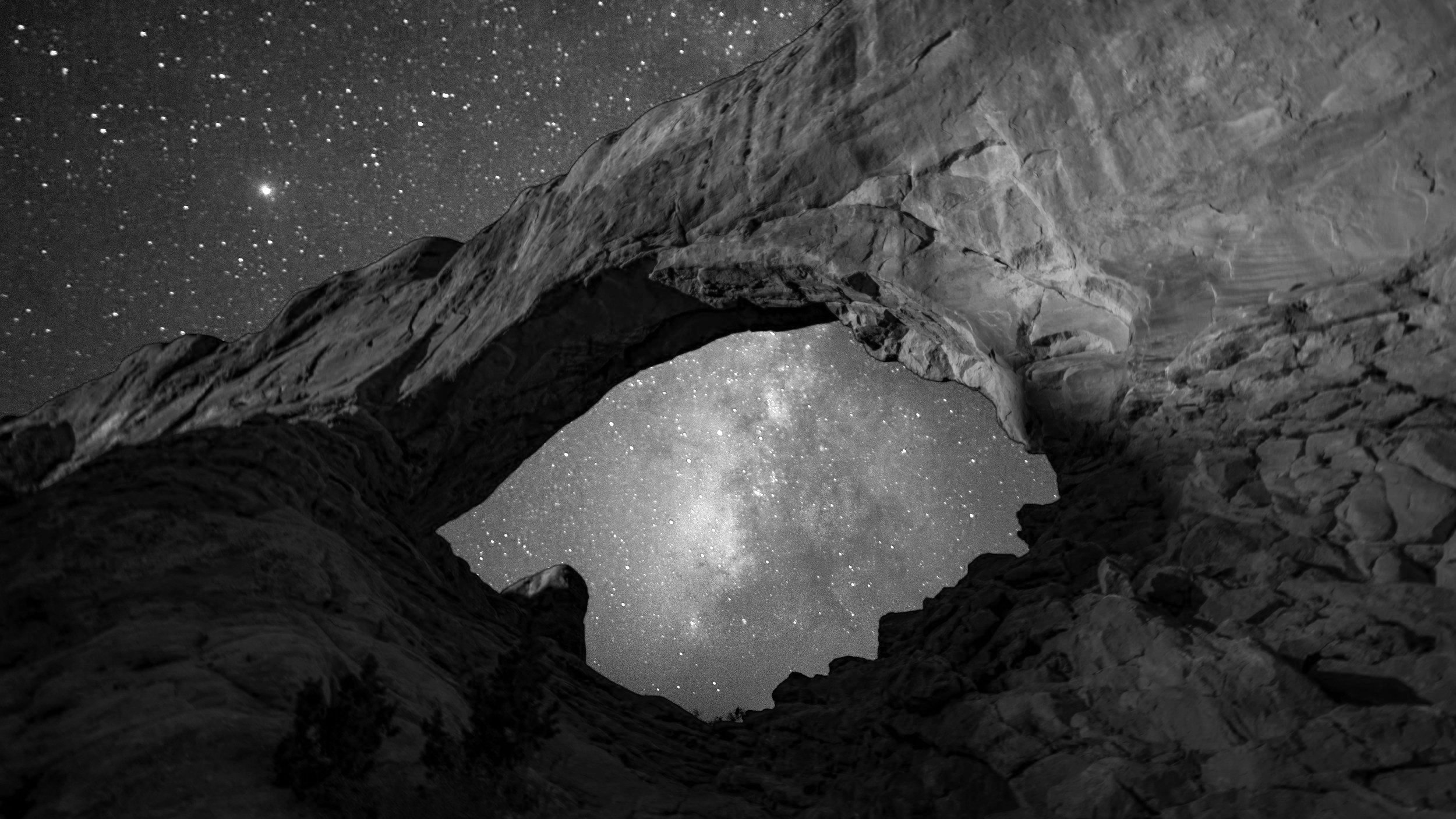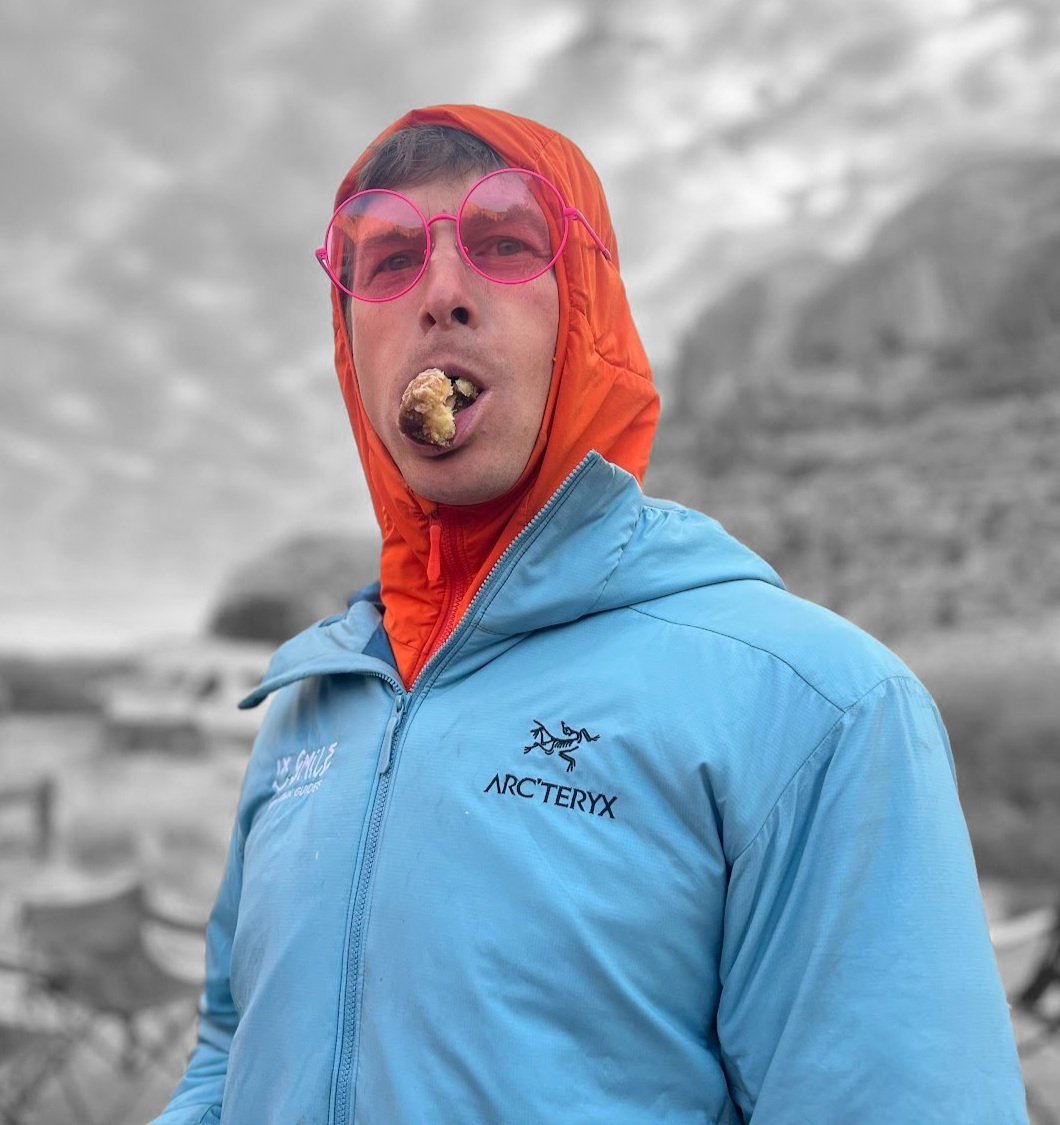
Castleton Tower Classics
Castleton Tower
Classics
Single:$525
2 CLIMBERS: $340 /PERSON
Advanced
Castle Valley, Utah
1-Day
Castleton Tower is world-renowned as a subject for photography and for its classic rock climbing routes, the most famous of which is the Kor-Ingalls Route featured in Fifty Classic Climbs of North America.
Many of the routes on Castleton are a bit more challenging than the other Moab area classics, making this experience a great goal in the progression of climbing more demanding routes after working with our team.

-
Castleton Tower is the namesake of the Castle Valley in Utah. A 400’ Wingate Sandstone tower standing on a 1,000’ Moenkopi-Chinle cone, makes it a sight to see.
The tower is world-renowned as a subject for photography and for its classic rock climbing routes, the most famous of which is the Kor-Ingalls Route featured in Fifty Classic Climbs of North America.
Many of the routes on Castleton are a bit more challenging than the other Moab area classics, making this experience a great goal in the progression of climbing more demanding routes after working with our team.
Here are links for the routes we guide:
-Fine Jade on The Rectory 5.11
Fine Jade has more sustained climbing than the other climbs we mentioned but it is not wide. Those who are good sport climbers with some crack climbing experience may enjoy this route if capable of climbing at the grade!
Overnight Logistics will be sorted with you and the office upon registration. Please email or call with questions.
Many people opt to sleep in a hotel in Moab but there is a small (free) campground on private land adjacent to the approach trail for the climb.
-
This adventure takes place in Moab, Utah
Pre-Adventure Trip Call:
Our team extends the offer to schedule a call before your guided tour. They will discuss route options for the day, review gear needs, and share a general time plan for the trip. This is also a great way to ask any questions about the day!
Morning:
Meet at the Castleton Tower Trailhead and share a quick morning hello, and the day’s itinerary. The team will make any small adjustments to the kit and then take a stroll to our climb.
An integral part of climbing is familiarity with the area and its history. Our team shares some stories and educates as we approach the climb.
The Climb:
After about an hour of hiking, we are at the base of the climb! Instructions and reminders on gear and its removal, proper hydration, the rope systems, and belaying will be covered. We finish with a partner check, and then the team climbs!
End Of Day Debrief:
At the cars, we focus our attention on the day; sharing the Rose, the Bud, and the Thorn to ruminate more deeply on the experience. It is often customary ( but not mandatory) to have a meal back in the town to celebrate the great days spent in the mountains!
-
During the Pennsylvanian Period (320-285 million years ago), much of Utah was covered by ocean. A small arm of the Ancestral Rockies penetrated into Utah from the east, north of the Moab area. Extending south from the tip of these highlands was an area that was occasionally submerged, occasionally "high and dry." The Moab region was a gigantic deep "sinkhole," called the Paradox Basin.
From time to time, the Paradox Basin would be flooded with ocean water as sea levels rose (or the land bridge subsided). A layer of limestone would form in this new ocean bay. Then the Paradox Basin would be cut off from the ocean and would dry out, leaving evaporated salts, capped with shale. Multiple such cycles occurred over millions of years, leaving over 1000 feet of salt. No rock of the Pennsylvanian Period is exposed at the surface in the Moab area, but the shape of the land has been affected by the Paradox Formation salt (more on this later).
Potash (a salt of potassium) is mined from Paradox Formation deposits deep under the Colorado River. The plant can be seen from here at the overlook at the end of the Amassa Back trail.
-
Ingalls was especially enthralled with Castleton and Fisher Towers, but he lacked the partner to climb them with. In 1959, he met Layton Kor. “There was an immediate rapport between us, and the next day we climbed the Bastille Crack in Eldorado Canyon,” Ingalls wrote in 1989. “I was amazed, even shocked by his ability. Here was the man for Castleton Tower.”
In, 1961 they explored the base of Castleton Tower. After finding a good line on the southeast face, later known as the Kor- Ingalls Route, Kor was off leading the pitches. The rock turned out to be delightfully solid, composed of Wingate Sandstone. The climb went smoothly until a storm gathered on the descent. Kor rappelled to the ground safely, but Ingalls was struck by a lightning ground shock through the rope. He was shaken, but unhurt.
Such storms can be fairly common on Castleton, but amazingly, after thousand of ascents, the only fatality on Castleton occurred from a lightning strike in 2005.
Typical of the style of many first ascents in the desert of Utah, the endeavor was a bold and dangerous undertaking, rife with adventure. Not to mention obscurity.
Besides Kor and Ingalls, there were several other climbers making a name for themselves in the desert. One of them was Harvey Carter, a skilled climber from Colorado Springs. He had an affinity for sandstone, especially since Garden of the Gods was his home stomping grounds. Credited with climbing 40 new towers, including the Priest in 1962 with Kor and Fred Beckey, Carter climbed several first ascents with Kor and Ingalls. But he missed out on Castleton, as well as Standing Rock.
Typical of the style of many first ascents in the desert of Utah, the endeavor was a bold and dangerous undertaking, rife with adventure.

-
FOOTWEAR
+Socks
UPPER LAYERS
+Synthetic T-shirt
For Colder Days Please Consider
BOTTOM LAYERS
GLOVES/HATS
+Buff
BACKPACKS
+15-20L Climbing Backpack
+35-55L Crag Pack
ACCESSORIES
+Sunglasses, Sunscreen, Lip Balm, Sun Hat
+Nalgene, Minimum 1.5L
+Climbing Snacks: 100 calories an hour!
EQUIPMENT
+Belay Device w/Locking Carabiner
+3 Additional Locking Carabiners
+120cm Sewn Sling w/ Non-Locker
+Autoblock Cord w/ Non-Locker
Smile Mountain Guides can supply rock climbing gear including helmets, harnesses, shoes, ropes, cams, slings, carabiners, belay/rappel devices.
-
AIR TRAVEL
There are regular flights to Salt Lake City, Denver, and Grand Junction.
Two flights arrive in Moab from Salt Lake City, UT on Delta/Skywest Moab Airport.
We suggest making your reservation as soon as possible as these flights fill up quickly.
If flights are sold out, your options include flying into Grand Junction- GJ Airport, Salt Lake City- SLC Airport, or Denver- DIA Airport and renting a car.
Grand Junction is the closest option, just two hours away. Salt Lake City is next at four hours and Denver is five and a half hours drive from Moab.
-
Moab offers all types of accommodations, from camping to high-end retreat spa ranches. For more information, visit DiscoverMoab.com.
For high-end accommodations, we recommend Gonzo Inn. Located downtown at 100 W. 200 S., Gonzo Inn offers luxurious and spacious rooms with an abundance of local flavor.
Equally impressive, the Sorrel River Ranch Resort & Spa’s private location along the Colorado River offers scenic views, luxury cabin suites with hydrotherapy tubs, full spa services, and massage therapy to soothe tired climbing muscles.
Middle-of-the-road (but very nice) lodging is available at Best Western Canyonlands Inn, located at 16 S. Main Street.
Even more economical is the Lazy Lizard Hostel (435-259-6057), 1213 S. Hwy. 191. Dorms ($10/night), private rooms ($24/night), and log cabins are available. Dorms are male, female, or co-ed and accommodate 4-8 people per room.
PREPARATIONS FOR CLIMBING CASTLETON TOWER
Technical Experience
Multi-pitch climbing experience is required for this adventure. It’s advisable to have some experience climbing wider cracks.
SMG requires guests to have prior guided experiences with our team before attempting to climb Castleton Tower or have a referral from another guide service showing climbing ability.
Fitness
Moderate physical fitness is strongly recommended. Climbers should be able to hike 1000 vertical feet and climb for approximately 8-10 hours while carrying a small pack.
Climbers should feel comfortable climbing traditional-styled routes at the 5.10 grade.
Meet The Team
FAQ’s
Climbing Castleton Tower
The answers to our most commonly asked questions for Castleton Tower.
-
PRICE INCLUDES
+Guide fees, AMGA Certified Rock Guide or Higher (2:1 climber-to-guide ratio)
+Group equipment such as ropes, helmets, harnesses, shoes, and technical climbing equipment.
+Small multi-pitch backpack
PRICE DOES NOT INCLUDE
+Personal equipment (see Gear List)
+Transportation
+Hotels/lodging in Moab
+All expenses incurred in the event of early departure (evac fees)
+Trip cancellation insurance
-
Smile Mountain Guides provides the following gear.
Technical:
+Helmets
+Harness
+Shoes
+Small backpack
+Ropes and group technical equipment
Smile Mountain Guides does not provide the clothing needed to be comfortable in the mountain environment.
-
Smile focuses on small groups and ratios that meet the professional mountain guiding standard. These programs have a 2:1 ratio.
We can accommodate a maximum group size of 6 climbers with 3 guides if the group chooses different climbing routes on Castleton Tower.
-
Please click here to review our domestic cancellation policy.
-
Yes! This is a custom adventure!
A large portion of our business is designed around custom adventures. Please email, climb@smilemountainguides.com if you would like more information.














